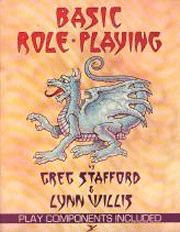
Basic Role-Playing (BRP) is a tabletop role-playing game which originated in the RuneQuest fantasy role-playing game. Chaosium released the BRP standalone booklet in 1980 in the boxed set release of the second edition of RuneQuest. Greg Stafford and Lynn Willis are credited as the authors. Chaosium used the percentile skill-based system as the basis for most of their games, including Call of Cthulhu, Stormbringer, and Elfquest.

Call of Cthulhu is a horror fiction role-playing game based on H. P. Lovecraft's story of the same name and the associated Cthulhu Mythos. The game, often abbreviated as CoC, is published by Chaosium; it was first released in 1981 and is in its seventh edition, with licensed foreign language editions available as well. Its game system is based on Chaosium's Basic Role-Playing (BRP) with additions for the horror genre. These include special rules for sanity and luck.

RuneQuest is a fantasy tabletop role-playing game originally designed by Steve Perrin, Ray Turney, Steve Henderson, and Warren James, and set in Greg Stafford's mythical world of Glorantha. It was first published in 1978 by The Chaosium. Beginning in 1984, publication passed between a number of companies, including Avalon Hill, Mongoose Publishing, and The Design Mechanism, before finally returning to Chaosium in 2016. RuneQuest is notable for its system, designed around percentile dice and an early implementation of skill rules, which became the basis for numerous other games. There have been several editions of the game.

Elric!, subtitled "Dark Fantasy Roleplaying", is a fantasy tabletop role-playing game published under license by Chaosium in 1993. Based on the Elric of Melniboné books by Michael Moorcock, this is the fifth edition of the game originally titled Stormbringer.
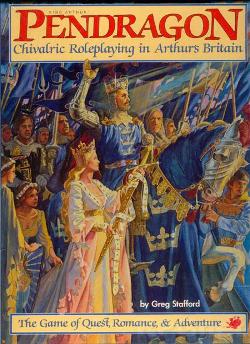
Pendragon, or King Arthur Pendragon, is a Tabletop role-playing game (RPG) in which players take the role of knights performing chivalric deeds in the tradition of Arthurian legend. It was originally written by Greg Stafford and published by Chaosium, then was acquired by Green Knight Publishing, who in turn passed on the rights to White Wolf Publishing in 2004. White Wolf sold the game to Stewart Wieck in 2009. Wieck formed Nocturnal Media, who updated and reissued the 5th edition originally published by White Wolf. In 2018, it returned to Chaosium.

Talislanta is a fantasy role-playing game published by Bard Games in 1987 that forgoes many of the tropes used by popular games of the genre in favor of a unique world and many new game mechanisms. There have been six different English-language editions and several foreign language editions published.
Worlds of Wonder is a multi-genre set of three role-playing games (RPGs) produced by Chaosium in 1982 that all used the Basic Role-Playing set of rules.

Ghostbusters, subtitled "A Frightfully Cheerful Roleplaying Game", is a comedy role-playing game published by West End Games (WEG) in 1986 that is based on the 1984 film Ghostbusters.
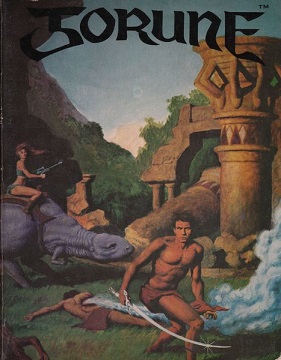
Skyrealms of Jorune is a science-fantasy role-playing game that was first published in 1984 through SkyRealms Publishing. The game is set on the fictional alien planet of Jorune above which float levitating islands. The second edition was published in 1986 as a boxed set, and a third edition was published by Chessex in 1992. The computer game Alien Logic: A Skyrealms of Jorune Adventure was published in 1994. The various editions received positive reviews in game periodicals including Casus Belli, White Dwarf, White Wolf, Different Worlds, Dragon, Polyhedron, The Games Machine, and Challenge.

Stormbringer is a fantasy tabletop role-playing game published under license by Chaosium. Based on the Elric of Melniboné books by Michael Moorcock, the game takes its name from Elric's sword, Stormbringer. The rules are based on Chaosium's percentile-dice-based Basic Role-Playing system.
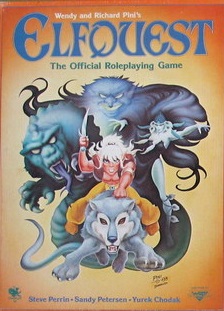
Elfquest is a fantasy role-playing game published by Chaosium in 1984 that is based on Wendy and Richard Pini's Elfquest series of comics.
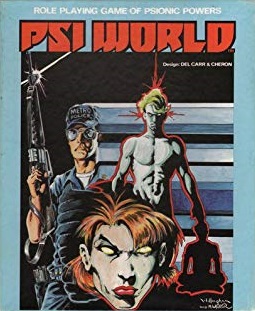
Psi World is a science fiction role-playing game published by Fantasy Games Unlimited (FGU) in 1984 that takes place in a near-future society in which certain individuals have psionic powers.
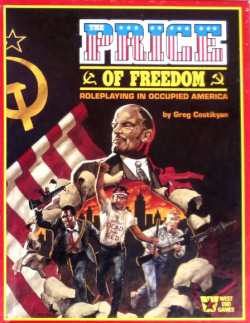
The Price of Freedom, subtitled "Roleplaying in Occupied America", is a role-playing game published by West End Games (WEG) in 1986 that depicts the uneven struggle between Soviet occupiers and an American resistance movement.
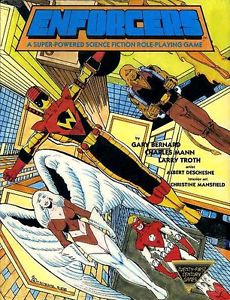
Enforcers is a near-future superhero role-playing game published by 21st Century Games in 1987.

Expendables is a science fiction role-playing game published by Stellar Games in 1987 in which the players take on the roles of interstellar explorers

The Pendragon Campaign is an Arthurian tabletop role-playing supplement, written by Greg Stafford, with art by Tom Sullivan, and published by Chaosium in 1985. This was the first product for the award-winning Pendragon game, an eighty-year campaign across Arthurian history.

Noble's Book is a 1985 fantasy tabletop role-playing game supplement for Pendragon published by Chaosium.

Ashes to Ashes is an adventure module published in Q3 1991 by White Wolf Publishing for use with their tabletop role-playing game Vampire: The Masquerade.

The Grey Knight is a Arthurian tabletop role-playing adventure, written by Larry DiTillio with art by Susan Seddon Boulet, and published by Chaosium in 1986. This was the first adventure published for the award winning game Pendragon.

The Shattered Isle: Rebels Against the Mutant Master is a science fantasy tabletop role-playing game supplement designed by Kerie Campbell-Robson, Steve Perrin, and Sandy Petersen and published by Chaosium in 1987. Designed to be used with Hawkmoon or Stormbringer, it provides new rules, background, and adventures for a campaign set in Eire.

















